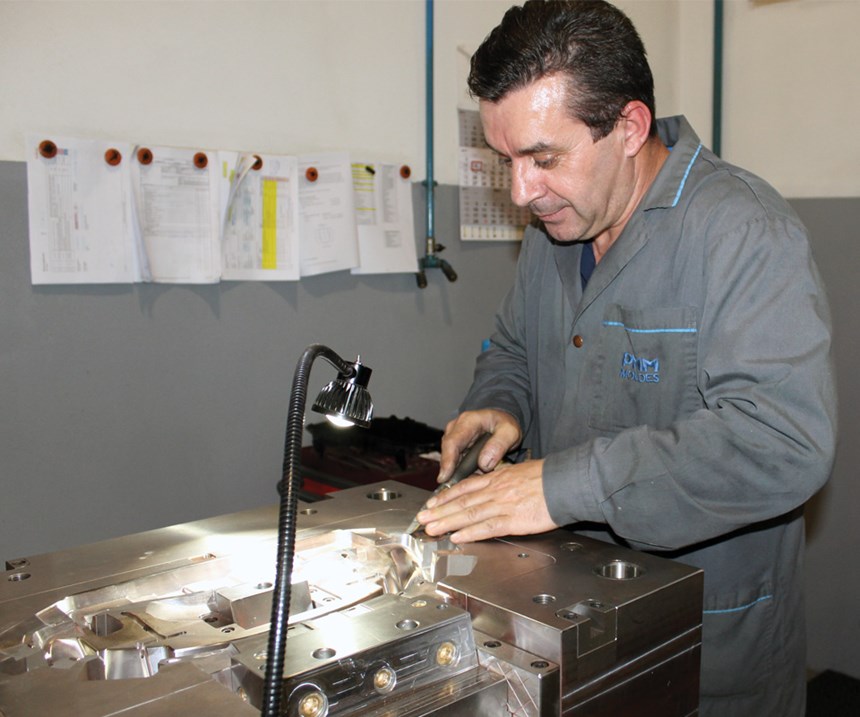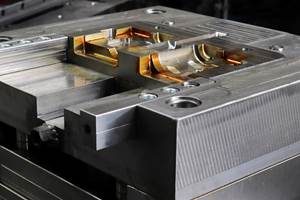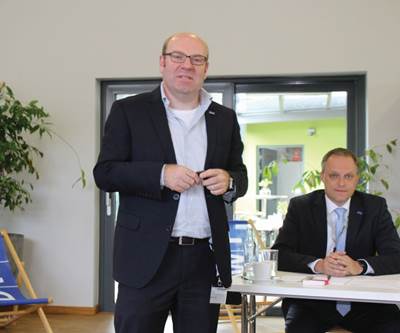International Perspective: The Electrochemical Mold Polishing Advantage
This process is said to reduce surface roughness caused by porosity, micro-cracks and the EDM recast layer by as much as seven times.
Most of Portugal’s 500-plus moldmakers are located either in Marinha Grande or Oliveira de Azemeis, both of which you can visit in a quick, two-hour trip from Lisbon. Projects, Molds and Manufacture Lda. (PMM) Moldes, located in Maceira in Marinha Grande, is one such shop. Founded in 1987, the company specializes in mold development and production for the plastics, rubber and die-casting industries. Apart from numerous five-axis machining centers, PMM also uses both wire and sinker EDMs, and electrode high-speed cutting machines, some of which are automated.
EDM is so essential for injection moldmaking that it is almost impossible to imagine a modern mold shop without an EDM. However, many molds still need surface finishing, because the surface of the mold has a direct impact on the surface of the product being molded. Parts manufactured through EDM often exhibit what is called a recast layer that results from the sparks produced during the EDM process melting the metal’s surface, which then undergoes ultra-rapid quenching. This layer is hard and has a good matrix adherence but should be removed by finishing operations. Proper finishing is essential and requires a variety of tools, materials and, most importantly, highly specialized skills that are not always easy to find.
While some products require manual polishing to meet extremely high demands on the surface finish, PMM has turned to a process called electrochemical polishing (ECP), which is said to reduce surface roughness caused by porosity, micro-cracks and the EDM recast layer by as much as seven times.
“Hand polishing is very labor-intensive and depends on the skills of the technician,” explains PMM Managing Director Virgílio Barbeiro. “ECP is an alternative. The result is a smooth, glossy metallic surface with properties identical to the base material and with no residual stresses.”
ECP should not be confused with electropolishing, Barbeiro emphasizes. ECP does not involve the use of dangerous acids and does not produce any poisonous gases or chemical byproducts, only saltwater.
How It Works
ECP takes advantage of a homogeneous electrostatic field that is built up in the gap between the mold surface and mating electrode when voltage is applied. If there is an electrolyte in that gap, a current will flow. This current will have uniform density if the gap is uniform. The current density used for ECP is very high, typically 40-80 A/cm², which is evenly distributed over the whole mold surface. The size of the gap can vary between 0.1 and 0.5 mm, but must be uniform over the whole surface.
The current forces the negative nitrate ions to the positive pole (the mold), where they react chemically with the material. These nitrates dissociate immediately (because the pH value of the electrolyte is around 8.5) and form an insoluble sludge of hydroxides. Then the surface of the mold is gradually dissolved. After dissolution of a layer about 0.1-mm thick, a metallically clean, uniform and glossy surface results that is completely free from micro-cracks and mechanical stresses generated by EDM or conventional milling and grinding.
“The machining time for ECP is always the same, independent of mold cavity size and shape,” says José Luís Malaquias, a consultant at Malaquias, Portugal. “The only requirement is a matching electrode, which can be made of the same material and geometry used for rough EDMing. If the EDM electrode shows little wear or damage, it can also be used as the ECP electrode.”
The parameters influencing the surface roughness produced by ECP include workpiece material quality, heat treatment, surface roughness before ECP, and electrode material and surface quality. “The surface finish of the electrode is also very important, as its imperfections and defects will be copied onto the mold surface,” he adds.
If a mirror-like finish is required, manual polishing with fine diamond or alumina is still necessary after ECP, Malaquias explains. “However, ECP makes this step much easier, as the hard recast layer is entirely removed. For final polishing, it is often sufficient to use diamond paste of size 6-3-1micron.”
According to Barbeiro, significant cost savings can be achieved, whether final polishing is required after ECP or not, by reducing or removing the need for medium and fine EDM and manual polishing. He adds that noise and dust emission is almost completely eliminated, improving the work environment.
PMM acquired its first ECP machine in 2000 and has been running three of these machines since 2008. They are not available off the shelf. The ECHODE 53-A6 can polish tools with an area as large as 660 cm² and as heavy as 500 kg. The maximum current delivered by the power supply is 24,000 amps. In Europe, ECP services are available exclusively from PMM. Any North American shops interested in this technology should contact PMM directly.
Related Content
What is Scientific Maintenance? Part 2
Part two of this three-part series explains specific data that toolrooms must collect, analyze and use to truly advance to a scientific maintenance culture where you can measure real data and drive decisions.
Read MorePredictive Manufacturing Moves Mold Builder into Advanced Medical Component Manufacturing
From a hot rod hobby, medical molds and shop performance to technology extremes, key relationships and a growth strategy, it’s obvious details matter at Eden Tool.
Read MoreHow to Use Diffusion Bonding to Optimize a Mold’s Thermal Performance
Joining dissimilar metals has tremendous potential for conformal cooling, but to successfully use diffusion bonding, a mold builder must understand the complexities of the interface and its effect on the chemical and thermo-mechanical properties of the bond.
Read MorePortable Low-Heat, Non-Arcing Resistance Welder for Mold Repair
Rocklin’s user-friendly MoldMender Micro Welder delivers simple and cost-effective localized repair in-house with precision and versatility, enhancing mold and die durability and reducing disassembly and downtime.
Read MoreRead Next
Int'l Perspective: Think Global, Act Local, and Cooperate
The new generation of company owners and managers count on cooperation with other mold shops or even competitors in order to remain globally competitive, and the moldmaking business is an increasingly global one.
Read MoreAre You a Moldmaker Considering 3D Printing? Consider the 3D Printing Workshop at NPE2024
Presentations will cover 3D printing for mold tooling, material innovation, product development, bridge production and full-scale, high-volume additive manufacturing.
Read MoreHow to Use Strategic Planning Tools, Data to Manage the Human Side of Business
Q&A with Marion Wells, MMT EAB member and founder of Human Asset Management.
Read More









_300x250 3.png;maxWidth=300;quality=90)



.jpg;maxWidth=300;quality=90)


.png;maxWidth=300;quality=90)











